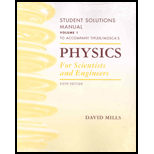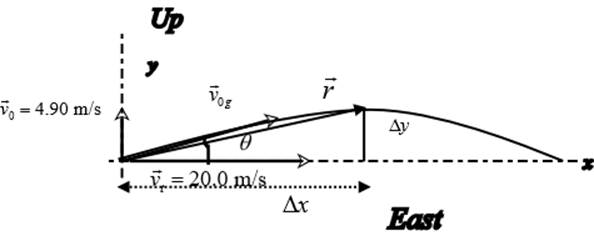
Concept explainers
(a)
The total time of flight of the ball as observed by the juggler in the train.
(a)
Answer to Problem 64P
The total time of flight of the ball as observed by the juggler in the train is found to be
Explanation of Solution
Given:
The initial velocity of the ball relative to the train
Formula used:
To determine the time of flight
Here,
Calculation:
The ball thrown in a train and the juggler are at rest with respect to the train. Choose a one dimensional coordinate system with the origin on the train and the positive y axis directed upwards. As the ball moves up and returns to the juggler’s hands, its displacement
Therefore,
Substitute these values in equation (1) and calculate the time of flight.
Conclusion:
Thus, the total time of flight of the ball as observed by the juggler in the train is found to be
(b)
The displacement of the ball during its rise as observed by the juggler.
(b)
Answer to Problem 64P
The displacement of the ball during its rise as observed by the juggler, is found to be
Explanation of Solution
Given:
The initial velocity of the ball relative to the train
Formula used:
To determine the displacement of the ball , the following equation of motion may be used.
Calculation:
As the ball moves upwards, it slows down due to the action of the Earth’s gravitational force. At the top most point of its trajectory, is instantaneous velocity v becomes zero.
Substitute the values of variables in the equation (2) and solve for
Conclusion:
Thus, the displacement of the ball during its rise as observed by the juggler, is found to be
(c)
The ball’s initial speed as observed by the friend on the ground.
(c)
Answer to Problem 64P
The ball’s initial speed as observed by the friend on the ground is found to be
Explanation of Solution
Given:
The initial velocity of the ball relative to the train
The velocity of the train relative to the ground
Formula used:
Using a coordinate system with the origin at the ground and the positive x axis along East, a vector diagram is constructed.

Figure 1
The person on the ground observes the ball to have a velocity
Calculation:
Substitute the values of variables in equation (3) and calculate the speed of the ball as observed by the person on the ground.
Conclusion:
Thus, the ball’s initial speed as observed by the friend on the ground is found to be
(d)
The angle of launch of the ball as observed by the person on the ground.
(d)
Answer to Problem 64P
The angle of launch of the ball as observed by the person on the ground
Explanation of Solution
Given:
The initial velocity of the ball relative to the train
The velocity of the train relative to the ground
Formula used:
Use Figure 1 to calculate the angle
Calculation:
Substitute the values of the variables in equation (4) and calculate the angle of launch of the ball as observed by the person on the ground.
Conclusion:
Thus, the angle of launch of the ball as observed by the person on the ground
(e)
The displacement of the ball during its rise as observed by the person on the ground.
(e)
Answer to Problem 64P
The displacement of the ball during its rise as observed by the person on the ground is found to be
Explanation of Solution
Given:
The initial velocity of the ball relative to the train
The velocity of the train relative to the ground
Formula used:
The displacement of the ball as seen by the person on the ground is given by the expression,
Here,
From Figure 1, it can be seen that the initial velocity
The time
The horizontal component of the ball’s velocity remains constant, since no force acts along the horizontal direction. While, since the acceleration of free fall acts downwards, the vertical component of the ball’s velocity varies with time.
The values of
Calculation:
The trajectory of the ball as seen by the person on the ground is shown in the diagram below;

At the top most point of its trajectory, the vertical component of the ball’s velocity becomes equal to zero. Use equation (7) and calculate the time taken by the ball to reach the top most point of its trajectory.
Calculate the value of
Calculate the value of
Substitute the values of
Conclusion:
Thus, the displacement of the ball during its rise as observed by the person on the ground is found to be
Want to see more full solutions like this?
Chapter 3 Solutions
Physics For Scientists And Engineers Student Solutions Manual, Vol. 1
- A particle initially located at the origin has an acceleration of a=3.00jm/s2 and an initial velocity of vi=5.00im/s. Find (a) the vector position of the particle at any time t, (b) the velocity of the particle at any time t, (c) the coordinates of the particle at t = 2.00 s, and (d) the speed of the particle at t = 2.00 s.arrow_forwardDoes a car moving around a circular track with constant speed have (a) zero acceleration, (b) an acceleration in the direction of its velocity, (c) an acceleration directed away from the center of its path, (d) an acceleration directed toward the center of its path, or (e) an acceleration with a direction that cannot be determined from the given information?arrow_forwardA rugby player passes the ball 9.75 m across the field, where it is caught at the same height as it left his hand. At what angle was the ball thrown if its initial speed was 12.0 m/s, assuming that the smaller of the two possible angles was used? What other angle gives the same range? For the pass using the smaller of the two angles, how long is the ball in the air?arrow_forward
- If an object is thrown horizontally with an average x-component of its velocity equal to 5 m/s, and does not hit the ground, what will be the x-component of the displacement after 20s?arrow_forwardA ball is thrown into the air at 60° angle to the ground, takes a parabolic path, and is in the air for a total time of 4 s. If the upward direction from the ground is positive, what is the best estimate of the ball’s velocity at a time 3 s after it leaves the ground?arrow_forwardThe F-35B Lighting II is a short-takeoff and vertical landing fighter jet. If it does a vertical takeoff to 20.00-m height above the ground and then follows a flight path angled at 30° with respect to the ground for 20.00 km, what is the final displacement?arrow_forward
- A football is punted from the ground, it passes through the apex of its flight, and it begins its downward decent. When its height above the field is h = 2.5m, the horizontal and vertical components of its velocity are observed to have the values v(horizontal) = 15 m/s and v(vertical) = 2.5 m/s, respectively. Use a Cartesian coordinate system with the origin located ar the inital position of the football. Ignore air resistance. Calculare the time, in seconds, from when the football left the ground until it is descending at a height of h = 2.5m.arrow_forwardA ball is tossed horizontally from the highest point of a 75 m building and lands 150 m from the base of the building. Ignore air resistance, and use a coordinate system whose origin is at the highest point of the building, with positive y upwards and positive x in the direction of the throw. How long is the ball in the air for, in seconds?arrow_forwardA missile is launched at an angle of 60 degrees up from the horizontal. Between 2 and 3 seconds after launch, it is seen to cover 30 m in the horizontal direction. With what speed (to 2 significant figures) was the rocket launched?arrow_forward
- A sniper atop a building 150m high fired a bullet parallel to the horizontal with a speed of 1800km/h. How long will it take the bullet to reach the ground?arrow_forwardIn a scene in an action movie, a stuntman jumps from the top of one building to the top of another building 4.00 m away. After a running start, he leaps at an angle of 15.0o with respect to the flat roof while traveling at a speed of 5.00 m/s. Will he make it to the other roof, which is 2.50 m shorter than the building he jumps from?arrow_forwardA child running in a field has the following position and velocity at time t=0: x = 1.5 m. v= -2.0 m. Vx =-3.5 m/s, vy = 1.0 m/s At time t = 2.5 s, it has the following position and velocitv: x = -1.0 m, y = 1.5 m 08. Vx = -0.50 m/s, Vy = 2.0 m/s Using this information, find the magnitude and direction of the child's…arrow_forward
 Principles of Physics: A Calculus-Based TextPhysicsISBN:9781133104261Author:Raymond A. Serway, John W. JewettPublisher:Cengage Learning
Principles of Physics: A Calculus-Based TextPhysicsISBN:9781133104261Author:Raymond A. Serway, John W. JewettPublisher:Cengage Learning
